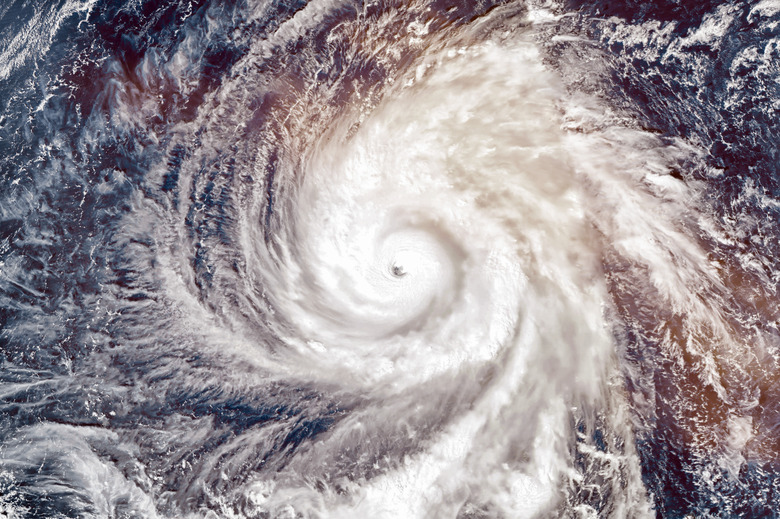Scientific Explanation Of Typhoons
A typhoon by any other name still spins as fast. That's because the typhoon definition is the same as that of a hurricane, cyclone or tropical storm: a giant, rotating system of clouds and storms characterized by low pressure and intensely strong winds. The only difference in its naming comes from where in the world it originates.
A hurricane in Japan is actually called a typhoon because the storm began in the Western Pacific. The word hurricane is reserved for Atlantic and Eastern Pacific storms. Meanwhile in the Indian Ocean, hurricanes are known as cyclones.
What's a Typhoon?
Typhoons are rotating weather systems that are typically a few hundred miles across and have wind speeds of 74 miles per hour (mph) or higher. In the center of the storm is a 20-40 mile region of calm air, called the eye.
A typhoon can grow to produce damaging winds, storm surges and tidal waves, torrential rain, flooding and other major damage. This happens when conditions of warm tropical waters and relatively high moisture persist for a significant period of time.
Because of this, most typhoons in the Northern Hemisphere occur in the summer or early fall months. In the Atlantic, hurricane season is "officially" from June 1 to November 30. However, that's no hard-and-fast rule, as these storms sometimes occur earlier or later in the year, too.
Due to the Earth's rotation and resulting weather patterns, most typhoons rotate counter-clockwise in the Northern Hemisphere and clockwise in the Southern Hemisphere.
Typhoon Meaning
The Greek word typhon means "whirlwind" and refers to a god who is also a monster and is personified as the father of wind. Typhoon has been in use since the 1500s, including in records of ship voyages to the East Indies.
Typhoon and Hurricane Categories
Before a typhoon (or hurricane or cyclone) reaches full strength, it is known as a tropical depression (winds of 38 mph or less) or a tropical storm (wind speeds of 39-73 mph). These smaller storms in warm waters near the equator can still cause significant damage to islands and coastal regions. Sometimes they develop into an official typhoon; other times, they peter out.
The National Hurricane Center and Central Pacific Hurricane Center categorize typhoons using the Saffir-Simpson Hurricane Wind Scale. The categories and their sustained wind speeds, and the center's descriptions of danger for each one, are found below:
• Category 1, 74-95 mph, very dangerous
• Category 2, 96-110 mph, extremely dangerous
• Category 3, 111-129 mph, devastating damage will occur
• Category 4, 130-156 mph, catastrophic damage will occur
• Category 5, 157 mph or higher, catastrophic damage will occur
Any storm rated a category 3 or higher is considered a major storm. In the Western North Pacific, any typhoon with wind speeds of 150 mph or higher is called a "super typhoon."
Climate Change and Storm Intensity
Warming ocean waters have been correlated with increasing frequencies of tropical storms and typhoons over the last several decades. Moreover, the damage from these storms is exacerbated by rising sea levels globally.
According to the Center for Climate and Energy Solutions, from 1966 to 2009 there were about 11 tropical storms and six hurricanes annually. These averages rose to about 16 tropical storms and eight hurricanes annually between 2000 to 2013.
In addition to more storms each year, some climate models show an increase in the intensity of storms, with more category 4 and 5 storms in the forecast. Of the 10 costliest storms on record, eight have occurred since 2004.
Naming Storms
Around the world, meteorologists name storms for quick and easy reference. According to the World Meteorological Organization, storms named after people are also easier to remember. The organization divides the world into 10 regions, each of which manages its own naming system.
In most regions, hurricanes, typhoons or cyclones are named alphabetically in order of appearance. For example, the first hurricane of the season might be Abigail, followed by Bob and Casey. When a storm is particularly epic or deadly, the name is retired.
Cite This Article
MLA
Dusto, Amy. "Scientific Explanation Of Typhoons" sciencing.com, https://www.sciencing.com/scientific-explanation-of-typhoons-12314877/. 22 November 2019.
APA
Dusto, Amy. (2019, November 22). Scientific Explanation Of Typhoons. sciencing.com. Retrieved from https://www.sciencing.com/scientific-explanation-of-typhoons-12314877/
Chicago
Dusto, Amy. Scientific Explanation Of Typhoons last modified August 30, 2022. https://www.sciencing.com/scientific-explanation-of-typhoons-12314877/
